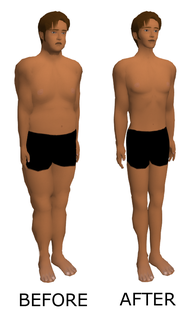Related Research Articles
Dieting is the practice of eating food in a regulated way to decrease, maintain, or increase body weight, or to prevent and treat diseases such as diabetes and obesity. Dieting to lose weight is recommended for people with weight-related health problems, but not otherwise healthy people. As weight loss depends on calorie intake, different kinds of calorie-reduced diets, such as those emphasising particular macronutrients, have been shown to be no more effective than one another. As weight regain is common, diet success is best predicted by long-term adherence. Regardless, the outcome of a diet can vary widely depending on the individual.

The Atkins diet is a low-carbohydrate fad diet devised by Robert Atkins in the 1970s, marketed with claims that carbohydrate restriction is crucial to weight loss and that the diet offered "a high calorie way to stay thin forever".

Weight loss, in the context of medicine, health, or physical fitness, refers to a reduction of the total body mass, by a mean loss of fluid, body fat, or lean mass. Weight loss can either occur unintentionally because of malnourishment or an underlying disease, or from a conscious effort to improve an actual or perceived overweight or obese state. "Unexplained" weight loss that is not caused by reduction in calorific intake or exercise is called cachexia and may be a symptom of a serious medical condition. Intentional weight loss is commonly referred to as slimming.

Low-carbohydrate diets restrict carbohydrate consumption relative to the average diet. Foods high in carbohydrates are limited, and replaced with foods containing a higher percentage of fat and protein, as well as low carbohydrate foods.
Basal metabolic rate (BMR) is the rate of energy expenditure per unit time by endothermic animals at rest. It is reported in energy units per unit time ranging from watt (joule/second) to ml O2/min or joule per hour per kg body mass J/(h·kg). Proper measurement requires a strict set of criteria to be met. These criteria include being in a physically and psychologically undisturbed state and being in a thermally neutral environment while in the post-absorptive state (i.e., not actively digesting food). In bradymetabolic animals, such as fish and reptiles, the equivalent term standard metabolic rate (SMR) applies. It follows the same criteria as BMR, but requires the documentation of the temperature at which the metabolic rate was measured. This makes BMR a variant of standard metabolic rate measurement that excludes the temperature data, a practice that has led to problems in defining "standard" rates of metabolism for many mammals.

The ketogenic diet is a high-fat, adequate-protein, low-carbohydrate diet that in medicine is used mainly to treat hard-to-control (refractory) epilepsy in children. The diet forces the body to burn fats rather than carbohydrates.

Weight gain is an increase in body weight. This can involve an increase in muscle mass, fat deposits, excess fluids such as water or other factors. Weight gain can be a symptom of a serious medical condition.
Calorie restriction is a dietary regimen that reduces food intake without incurring malnutrition. "Reduce" can be defined relative to the subject's previous intake before intentionally restricting food or beverage consumption, or relative to an average person of similar body type.

A healthy diet is a diet that maintains or improves overall health. A healthy diet provides the body with essential nutrition: fluid, macronutrients such as protein, micronutrients such as vitamins, and adequate fibre and food energy.

An underweight person is a person whose body weight is considered too low to be healthy. The same concept applies to animals.
The Cambridge Diet was a very-low-calorie meal replacement fad diet developed in the 1960s. The diet launched with different versions in the US and the UK. The US version filed for bankruptcy and shut down shortly after the deaths of several dieters. The UK diet has also been known as the Cambridge Weight Plan, but is now known as The 1:1 Diet.

Protein–energy malnutrition (PEM), sometimes called protein-energy undernutrition (PEU), is a form of malnutrition that is defined as a range of conditions arising from coincident lack of dietary protein and/or energy (calories) in varying proportions. The condition has mild, moderate, and severe degrees.

A very-low-calorie diet (VLCD) or very-low-energy diet (VLED), also known as semistarvation diet and crash diet, is a type of diet with very or extremely low daily food energy consumption. Although previously described as a fad diet, VLCD now have extensive scientific evidence supporting their use, it is defined as a diet of 800 kilocalories (3,300 kJ) per day or less. Modern medically supervised VLCDs use total meal replacements, with regulated formulations in Europe and Canada which contain the recommended daily requirements for vitamins, minerals, trace elements, fatty acids, protein and electrolyte balance. Carbohydrates may be entirely absent, or substituted for a portion of the protein; this choice has important metabolic effects. Medically supervised VLCDs have specific therapeutic applications for rapid weight loss, such as in people living with obesity who need joint replacement surgery or before a bariatric surgery, using formulated, nutritionally complete liquid meals containing 800 kilocalories or less per day for a maximum of 12 weeks.

A low-fat diet is one that restricts fat, and often saturated fat and cholesterol as well. Low-fat diets are intended to reduce the occurrence of conditions such as heart disease and obesity. For weight loss, they perform similarly to a low-carbohydrate diet, since macronutrient composition does not determine weight loss success. Fat provides nine calories per gram while carbohydrates and protein each provide four calories per gram. The Institute of Medicine recommends limiting fat intake to 35% of total calories to control saturated fat intake.

Intermittent fasting, also known as intermittent energy restriction, is any of various meal timing schedules that cycle between voluntary fasting and non-fasting over a given period. Methods of intermittent fasting include alternate-day fasting, periodic fasting, and daily time-restricted feeding.
The South Beach Diet is a popular fad diet developed by Arthur Agatston and promoted in a best-selling 2003 book. It emphasizes eating food with a low glycemic index, and categorizes carbohydrates and fats as "good" or "bad". Like other fad diets, it may have elements which are generally recognized as sensible, but it promises benefits not backed by supporting evidence or sound science.

Weight management includes the techniques and physiological processes that contribute to a person's ability to attain and maintain a certain weight. Most weight management techniques encompass long-term lifestyle strategies that promote healthy eating and daily physical activity. Moreover, weight management involves developing meaningful ways to track weight over time and to identify ideal body weights for different individuals.
George A. Bray is an American obesity researcher. As of 2016, he is a University Professor emeritus and formerly the chief of the division of clinical obesity and metabolism at Louisiana State University's Pennington Biomedical Research Center in Baton Rouge. He is also a Boyd Professor emeritus at the Pennington Center, and a professor of medicine emeritus at the Louisiana State University Medical Center.
Weight Watchers or WW is a commercial program for weight loss based on a point system, meals replacement and counseling.
References
- ↑ Bal, Bikram S.; Finelli, Frederick C.; Koch, Timothy R. (19 April 2012), "Nutritional Requirements of the Critically Ill Obese Patient", Critical Care Management of the Obese Patient, Wiley-Blackwell, pp. 186–194, doi:10.1002/9781119962083.ch21, ISBN 9781119962083
- 1 2 3 4 Chang, J; Kashyap, SR (September 2014). "The protein-sparing modified fast for obese patients with type 2 diabetes: what to expect". Cleveland Clinic Journal of Medicine. 81 (9): 557–65. doi:10.3949/ccjm.81a.13128. PMID 25183847. S2CID 4345893.
- ↑ Gilman SL (2007). "Linn, Robert (1933–)". Diets and Dieting: A Cultural Encyclopedia. Routledge. p. 160. ISBN 978-1-135-87068-3.
- ↑ Cleveland Clinic Foundation (22 January 2016). "The Protein-Sparing Modified Fast Diet". Global Pediatric Health. 3: 2333794X15623245. doi:10.1177/2333794X15623245. PMC 4784653 . PMID 27335996.
- ↑ Nuttall FQ, Gannon MC (2013). "Dietary protein and the blood glucose concentration". Diabetes. 62 (5): 1371–2. doi:10.2337/db12-1829. PMC 3636610 . PMID 23613553.
- ↑ Manninen, Anssi (2006). "Very-low-carbohydrate diets and preservation of muscle mass". Nutr Metab (Lond). 3: 9. doi:10.1186/1743-7075-3-9. PMC 1373635 . PMID 16448570.
- ↑ Bryner, Randy (1999). "Effects of Resistance vs. Aerobic Training Combined With an 800 Calorie Liquid Diet on Lean Body Mass and Resting Metabolic Rate". Journal of the American College of Nutrition. 18 (2): 115–121. doi:10.1080/07315724.1999.10718838. PMID 10204826 . Retrieved 10 July 2017.
- ↑ praktischabnehmen (26 November 2021). "Protein-calorie malnutrition" (in German).
- ↑ Blackburn, C. L.; Flatt, J. P.; Clowes, G. H. A.; Oʼdonnell, T. F.; Hensle, T. E. (May 1973). "Protein Sparing Therapy during Periods of Starvation with Sepsis or Trauma". Annals of Surgery. 177 (5): 588–94. doi:10.1097/00000658-197305000-00012. ISSN 0003-4932. PMC 1355601 . PMID 4634108.
- 1 2 Thomas, Dylan D.; Istfan, Nawfal W.; Bistrian, Bruce R.; Apovian, Caroline M. (February 2018). "Protein sparing therapies in acute illness and obesity: a review of George Blackburn's contributions to nutrition science". Metabolism. 79: 83–96. doi:10.1016/j.metabol.2017.11.020. PMC 5809291 . PMID 29223678.
- ↑ Engelman, Ralph (July 1989). "Joseph C. Goulden. Fit to Print: A.M. Rosenthal and His Times". American Journalism. 6 (3): 202–204. doi:10.1080/08821127.1989.10731199. ISSN 0882-1127.
- ↑ Isner, J M; Sours, H E; Paris, A L; Ferrans, V J; Roberts, W C (December 1979). "Sudden, unexpected death in avid dieters using the liquid-protein-modified-fast diet. Observations in 17 patients and the role of the prolonged QT interval". Circulation. 60 (6): 1401–1412. doi: 10.1161/01.CIR.60.6.1401 . ISSN 0009-7322. PMID 498466.
- ↑ Bistrian, Bruce R. (17 November 1978). "Clinical Use of a Protein-Sparing Modified Fast". JAMA: The Journal of the American Medical Association. 240 (21): 2299–302. doi:10.1001/jama.1978.03290210081040. ISSN 0098-7484. PMID 702762.
- ↑ Cleveland Clinic Foundation (28 March 2018). "Study: PSMF Diet Shown To Provide Long-term Weight Loss".
- ↑ Center for Value-Based Care Research (8 January 2020). "The Effect of Starting the Protein-Sparing Modified Fast on Weight Change over 5 years". Journal of General Internal Medicine. 35 (3): 704–710. doi:10.1007/s11606-019-05535-0. PMC 7080885 . PMID 31916212.